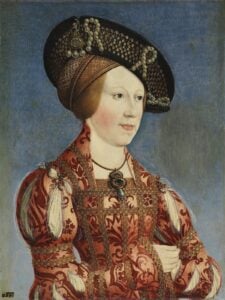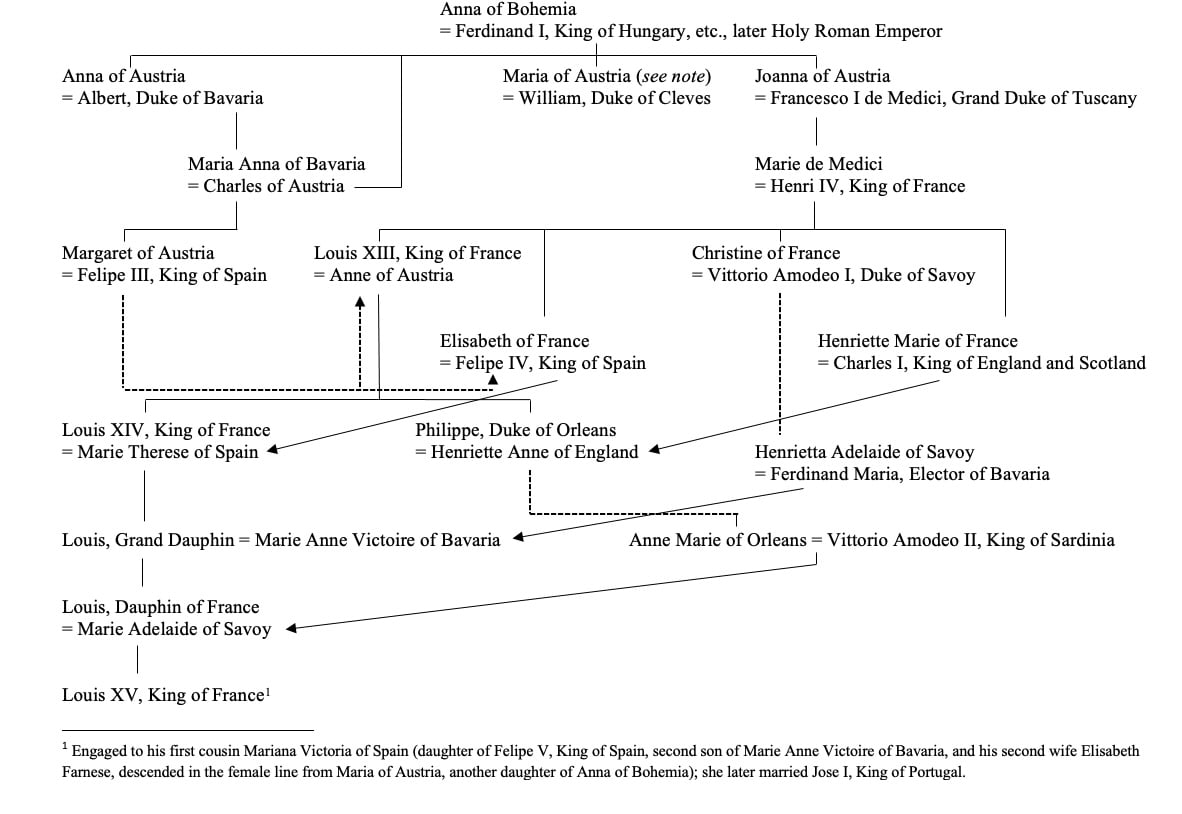Sometimes – as Chris Child and Jeff Record know – one gets drawn back to the same subject matter only to find new patterns. (I would venture to say many other genealogists know this dynamic well.) For me, in this example, it is an interest in matrilineal lines, a favorite subject of my colleague Julie Helen Otto; lately, this interest has taken shape around the progeny of Anna of Bohemia, Queen of Hungary, whose husband later succeeded as Holy Roman Emperor. To look at her daughters’ daughters (and daughters’ sons) is to enter a thicket of queens and kings, empresses and princes. Famously, both Queen Victoria and Catherine the Great descend from Anna through the female line – a subject for another post, perhaps?
Today, though, I want to focus on the curious fact that an unbroken series of Queens of France (and the wives of the Dauphin, or Crown Prince, known as Dauphines) were matrilineal descendants of Anna of Bohemia, which means that, with the exception of Henri IV, the Kings and Dauphins of France in this line were Anna’s matrilineal descendants as well.
What can it have meant, that Marie de Medici, her daughter-in-law Anne of Austria, her daughter-in-law (and niece) Marie Therese of Spain, her daughter-in-law Marie Anne Victoire of Bavaria, and her daughter-in-law Marie Adelaide of Savoy (as well as Marie Adelaide’s prospective daughter-in-law, Marianne Victoire of Spain) all descended in the female line from this Queen of Hungary? While each bride offered inducements to the French kings – Marie Therese was the eventual heiress of Spain – these princesses belonged to the rare caste of woman eligible to marry a King of France. And, yet, there were other brides of equal eligibility, so it seems extraordinary that Henri IV, Louis XIII, Louis XIV, and Louis XIV’s son, grandson, and great-grandson (later Louis XV) married (or became engaged to) women from the same ancestral stock.
Another way of looking at it: Henri IV and Marie de Medici were a patrilineal couple in the ancestry of their son Louis XIII and his successors, but they were also a matrilineal couple in the ancestry of Marie Therese of Spain (Louis XIV’s first wife), Marie Anne Victoire of Bavaria (wife of the Grand Dauphin), and Marie Adelaide of Savoy (wife of the Duke of Burgundy, later the second Dauphin of Louis XIV, and the parents of Louis XV).
Seeing it in chart form helps. Louis XIII and his sister Elisabeth married their second cousins (from France’s most important near neighbor); Louis XIV and his brother Philippe married their first cousins; and the Grand Dauphin and the younger Dauphin married second cousins – more to the point, King Louis XIV was well aware of the Electress of Bavaria (his first cousin) and the Duchess of Savoy (Marie Adelaide’s mother), his niece. So these were important marriages, dynastically and politically, but they were within comparatively close family connections, no matter how distant the bride’s home country.
Finally, in the engagement of the child King Louis XV and his first cousin, daughter of his late father’s brother King Felipe V, there was a brief attempt at keeping this important alliance to the fore. Instead, Louis XV married the Princess of Poland, Marie Lescynska. Of course, a generation later Louis XV’s son, the Dauphin of the day, married Mariana Victoria’s younger sister, another matrilineal descendant of Anna of Bohemia – but, really, it’s all too much!
Share this:
About Scott C. Steward
Scott C. Steward has been NEHGS’ Editor-in-Chief since 2013. He is the author, co-author, or editor of genealogies of the Ayer, Le Roy, Lowell, Saltonstall, Thorndike, and Winthrop families. His articles have appeared in The New England Historical and Genealogical Register, NEXUS, New England Ancestors, American Ancestors, and The Pennsylvania Genealogical Magazine, and he has written book reviews for the Register, The New York Genealogical and Biographical Record, and the National Genealogical Society Quarterly.View all posts by Scott C. Steward →

